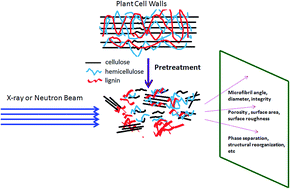Theory, practice and prospects of X-ray and neutron scattering for lignocellulosic biomass characterization: towards understanding biomass pretreatment
Abstract
Efficient deconstruction of lignocelluosic biomass into fermentable sugar depends largely on the development of advanced biomass pretreatment technologies. Due to the highly heterogeneous nano- and microstructure of the plant cell walls, there is a lack of understanding with regard to interactions between biomass recalcitrance and biomass pretreatment. Progress has been made by comparing the changes in chemical compositions and physical structures during the pretreatment processes and their correlations with the enzymatic hydrolysis of pretreated biomass. Recent studies suggest the necessity of investigating the impact of biomass pretreatment on plant cell walls using analytical tools spanning multiple length scales. Scattering techniques including X-ray and neutron scattering, complementary to imaging techniques, offer several advantages like minimal sample preparation, versatile sample environment and in situ dynamic investigation of cell wall structures. The combination of wide and small angle scattering (WAS and SAS) techniques covers length scales from a few angstroms to several hundred nanometres. In this review article, a detailed overview of the application of WAS and SAS techniques to study the supramolecular structures of cellulose and lignin, the examination of the presence of pores in plant cell walls as well as in the cellulose fibres are presented. In situ enzymatic hydrolysis of cellulose investigated by SAS, providing important insight into enzyme–biomass interactions, is also summarized. This review highlights how probing structural changes during pretreatment of biomass samples by WAS and SAS can reveal valuable information that is often not accessible by other techniques.


 Please wait while we load your content...
Please wait while we load your content...